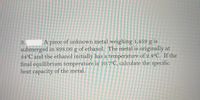
Chemistry
10th Edition
ISBN: 9781305957404
Author: Steven S. Zumdahl, Susan A. Zumdahl, Donald J. DeCoste
Publisher: Cengage Learning
expand_more
expand_more
format_list_bulleted
Question

Transcribed Image Text:3.
A piece of unknown metal weighing 1,459 g is
submerged in 898.06 g of ethanol. The metal is originally at
34°C and the ethanol initially has a temperature of 2.4°C. If the
final equilibrium temperature is 10.7°C, calculate the specific
heat capacity of the metal.
Expert Solution
This question has been solved!
Explore an expertly crafted, step-by-step solution for a thorough understanding of key concepts.
Step by stepSolved in 2 steps with 1 images

Knowledge Booster
Learn more about
Need a deep-dive on the concept behind this application? Look no further. Learn more about this topic, chemistry and related others by exploring similar questions and additional content below.Similar questions
- Define specific heat capacity. the quantity of heat required to raise the temperature of 1 mole of a substance by 1°C the quantity of heat required to change a system's temperature by 1°C the quantity of heat required to raise the temperature of 1 gram of a substance by 1°C the quantity of heat required to raise the temperature of 1 gram of a substance by 1°F the quantity of heat required to raise the temperature of 1 liter of a substance by 1°Carrow_forwardWhen a 8.00 g8.00 g sample of RbBrRbBr is dissolved in water in a calorimeter that has a total heat capacity of 3.03 kJ⋅K−1,3.03 kJ⋅K−1, the temperature decreases by 0.350 K.0.350 K. Calculate the molar heat of solution of RbBr.arrow_forwardSuppose 200.0 mL of 0.50 M HCl and 200.0 mL of 0.50 M NaOH, both initially at 25.0°C, are mixed in a thermos flask. When the reaction is complete, the temperature is 28.4°C. Assuming that the solutions have the same heat capacity as pure water, compute the heat released (in kJ).arrow_forward
- Consider an unknown metal X with a mass of 67.5 g at an initial temperature of 76.1 °C. The metal is placed in 88.7 g of water initially at 20.5 °C in an insulated container. The final equilibrium temperature of the system is 32.1 °C. Calculate the specific heat (J/(g·°C)) of the metal X. Use Cs = 4.18 J/(g·°C) for the specific heat of water. Assume that the only energy exchange that occurs is between the metal and the water.arrow_forwardA particular container holds 3.77 mol of neon gas. The volume of this container can be altered by sliding a piston in or out. The volume is changed from 8.60 L to 12.20 L while at the same time the temperature is changed from 303 K to 345 K. The molar heat capacity, Cym, for neon is 12.47 J/(mol · K). Assume that this value will not change over the given temperature range. What is the change in entropy for the gas? AS = J/K TOOLS x10 MacBook Proarrow_forwardThe molar heat of solution of a substance is found to be +21.38 kJ/mol. The addition of 0.100 mol of this substance to 1.000L of water initially at 40.0 degrees celsius results in a temperature decrease. Assume the specific heat of the resulting solution to be equal to that of pure water. Find the final temperature of the solution (Also assume that the heat capacity of the calorimeter is negligible).arrow_forward
- A 56.1 g sample of polystyrene, which has a specific heat capacity of 1.880 J-g °C-1 is put into a calorimeter (see sketch at right) that contains 250.0 g of water. The temperature of the water starts off at 24.0 °C. When the temperature of the water stops changing it's 29.8 °C. The pressure remains constant at 1 atm. Calculate the initial temperature of the polystyrene sample. Be sure your answer is rounded to the correct number of significant digits. °C thermometer. insulated container water sample. a calorimeter 區 OU Ararrow_forwardA student is attempting to determine the heat capacity of a Styrofoam cup calorimeter by pouring hot water into a Styrofoam cup containing cold water. The student determined the mass of the cold water to be 21.2455 g and its initial temperature to be 20.36 °C. The mass of the hot water was 24.2646 g and its initial temperature as 34.54 °C. The final temperature of the water after mixing was determined to be 24.57°C. The specific heat capacity of the water is 4.184 J/(g•°C). What is the heat capacity of the Styrofoam cup calorimeter? Assume the temperature of the calorimeter is the same temperature as the cold water. 4.184 J/°C 132.5 J/°Carrow_forward
arrow_back_ios
arrow_forward_ios
Recommended textbooks for you
 ChemistryChemistryISBN:9781305957404Author:Steven S. Zumdahl, Susan A. Zumdahl, Donald J. DeCostePublisher:Cengage Learning
ChemistryChemistryISBN:9781305957404Author:Steven S. Zumdahl, Susan A. Zumdahl, Donald J. DeCostePublisher:Cengage Learning ChemistryChemistryISBN:9781259911156Author:Raymond Chang Dr., Jason Overby ProfessorPublisher:McGraw-Hill Education
ChemistryChemistryISBN:9781259911156Author:Raymond Chang Dr., Jason Overby ProfessorPublisher:McGraw-Hill Education Principles of Instrumental AnalysisChemistryISBN:9781305577213Author:Douglas A. Skoog, F. James Holler, Stanley R. CrouchPublisher:Cengage Learning
Principles of Instrumental AnalysisChemistryISBN:9781305577213Author:Douglas A. Skoog, F. James Holler, Stanley R. CrouchPublisher:Cengage Learning Organic ChemistryChemistryISBN:9780078021558Author:Janice Gorzynski Smith Dr.Publisher:McGraw-Hill Education
Organic ChemistryChemistryISBN:9780078021558Author:Janice Gorzynski Smith Dr.Publisher:McGraw-Hill Education Chemistry: Principles and ReactionsChemistryISBN:9781305079373Author:William L. Masterton, Cecile N. HurleyPublisher:Cengage Learning
Chemistry: Principles and ReactionsChemistryISBN:9781305079373Author:William L. Masterton, Cecile N. HurleyPublisher:Cengage Learning Elementary Principles of Chemical Processes, Bind...ChemistryISBN:9781118431221Author:Richard M. Felder, Ronald W. Rousseau, Lisa G. BullardPublisher:WILEY
Elementary Principles of Chemical Processes, Bind...ChemistryISBN:9781118431221Author:Richard M. Felder, Ronald W. Rousseau, Lisa G. BullardPublisher:WILEY

Chemistry
Chemistry
ISBN:9781305957404
Author:Steven S. Zumdahl, Susan A. Zumdahl, Donald J. DeCoste
Publisher:Cengage Learning

Chemistry
Chemistry
ISBN:9781259911156
Author:Raymond Chang Dr., Jason Overby Professor
Publisher:McGraw-Hill Education

Principles of Instrumental Analysis
Chemistry
ISBN:9781305577213
Author:Douglas A. Skoog, F. James Holler, Stanley R. Crouch
Publisher:Cengage Learning

Organic Chemistry
Chemistry
ISBN:9780078021558
Author:Janice Gorzynski Smith Dr.
Publisher:McGraw-Hill Education

Chemistry: Principles and Reactions
Chemistry
ISBN:9781305079373
Author:William L. Masterton, Cecile N. Hurley
Publisher:Cengage Learning

Elementary Principles of Chemical Processes, Bind...
Chemistry
ISBN:9781118431221
Author:Richard M. Felder, Ronald W. Rousseau, Lisa G. Bullard
Publisher:WILEY